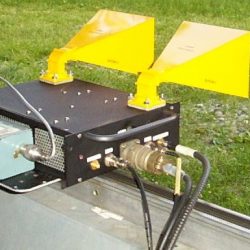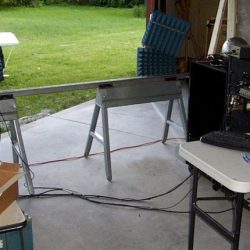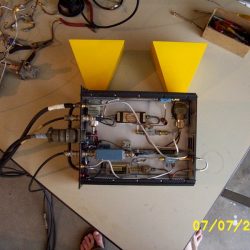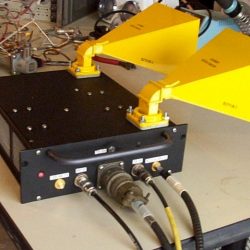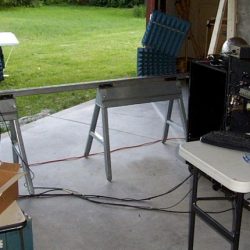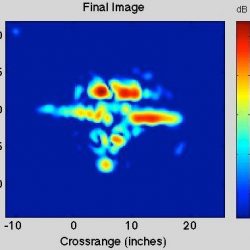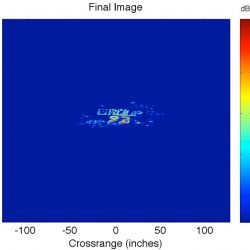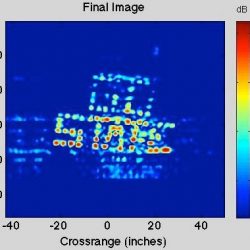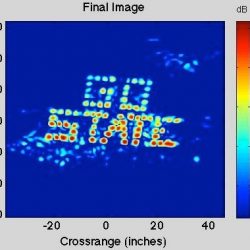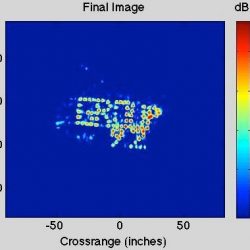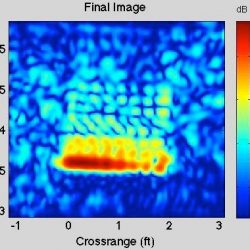Low-Power X-Band Rail SAR
UWB X-band Rail SAR Imaging System
This system was developed as part of my PhD dissertation at the Michigan State University Electromagnetics Research Group.
- 7.5-12.5 GHz UWB linear FM chirp
- Simultaneous transmit and receive (FMCW radar mode)
- 10 mW transmit power
- Range gate
- High sensitivity capable of imaging pushpins and model aircraft
- Nano-watt radar operation
Abstract
A near real-time radar-based imaging system is developed in this dissertation. This system uses the combination of a spatially diverse antenna array, a high sensitivity range-gated frequency-modulated continuous wave (FMCW) radar system, and an airborne synthetic aperture radar (SAR) imaging algorithm to produce near real-time high resolution imagery of what is behind a dielectric wall. This system is capable of detecting and providing accurate imagery of target scenes made up of objects as small as 6 inch tall metallic rods and cylinders behind a 4 inch thick dielectric slab. A study is conducted of through-dielectric slab imaging by the development of a 2D model of a dielectric slab and cylinder.
The SAR imaging algorithm is developed and tested on this model for a variety of simulated imaging scenarios and the results are then used to develop an unusually high sensitivity range-gated FMCW radar architecture. An S-band rail SAR imaging system is developed using this architecture and used to image through two different dielectric slabs as well as free-space. All results are in agreement with the simulations. It is found that free-space target scenes could be imaged using low transmit power, as low as 5 picowatts. From this result it was decided to develop an X-band front end which mounts directly on to the S-band rail SAR so that objects as small as groups of pushpins and aircraft models in free-space could be imaged. These results are compared to previous X-band direct conversion FMCW rail SAR work. It was found that groups of pushpins and models could be imaged at transmit powers as low as 10 nanowatts.
A spatially diverse S-band antenna array will be shown to be developed for use with the S-band radar; thereby providing the ability for near real-time SAR imaging of objects behind dielectric slabs with the same performance characteristics of the S-band rail SAR. The research presented in this dissertation will show that near real-time radar imaging through lossy-dielectric slabs is accomplished when using a highly sensitive radar system located at a stand-off range from the slab using a free-space SAR imaging algorithm.
Publications
- G. L. Charvat, L. C. Kempel, C. Coleman, “A Low-Power High-Sensitivity X-Band Rail SAR Imaging System,” IEEE Antennas and Propagation Magazine, Vol. 50, No 3, June 2008, pp. 108-115.
- Draft of this Article
- G. L. Charvat, ``A Low-Power Radar Imaging System," Ph.D. dissertation, Dept. of Electrical and Computer Engineering, Michigan State University, East Lansing, MI, 2007.
- A Low-Power Radar IMaging System Dissertation Defense PPT
Engineering Notes
The X-Band Rail SAR Hardware
An X-band front end was developed for this dissertation to test the ability of this radar system in an RCS measurement application. This front end simply plugs into the S-band rail SAR IF/data acquisition racks and bolts on to the mechanized rail. This X-band rail SAR was shown to be capable of imaging groups of pushpins using extremely low amounts of power, down to 10 nano-watts.
The X-Band Rail SAR Imagery
An X-band front end was developed for this dissertation to test the ability of this radar system in an RCS measurement application. This front end simply plugs into the S-band rail SAR IF/data acquisition racks and bolts on to the mechanized rail. This X-band rail SAR was shown to be capable of imaging groups of pushpins using extremely low amounts of power, down to 10 nano-watts. Other high sensitivity imagery was acquired showing positive results.
